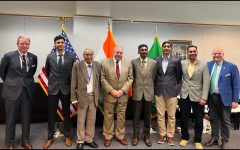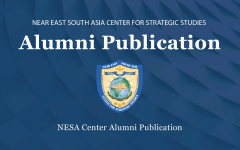The Biden Administration and Artificial Intelligence: The New Driver of Policy in South Asia
May 21, 2021 2025-06-27 17:19The Biden Administration and Artificial Intelligence: The New Driver of Policy in South Asia
The Biden Administration and Artificial Intelligence: The New Driver of Policy in South Asia

In the ninth segment of the NESA Interview Series, Professor Hassan Abbas interviews Dr. Al Naqvi, CEO of the American Institute of Artificial Intelligence (AIAI). The ideas expressed here are drawn from a conversation between Professors Hassan Abbas and Al Naqvi as part of NESA conversations about South Asia.
The rise of artificial intelligence (AI) has launched a new era for policy. As the term great power competition (GPC) has come into vogue in policy circles, the new competitive dynamics are a result of the underlying tectonic shifts in the scientific and technological arenas. Policy outlook for India and Pakistan must also be based upon such considerations. We begin by creating a link between AI and GPC, discuss its strategic implications, and end our analysis with identifying the concept of strategic binarization in South Asia.
Global Data Conflict (GDC):
As the GPC rhetoric heats up, pundits are suggesting we are in a new cold war with China. We contend that it is neither a cold war nor a hot war scenario. The new U.S. and China rivalry is primarily a “Data War”. It is not any less dangerous, nonetheless.
GDC contains all the elements of previous global competitive rivalries, such as those experienced in the Cold War, but it also has its own realities that can create unpredictable dynamics and extraordinary checkmate moves on the chessboard. It is far more lethal, far more dangerous, and far more disruptive. Its dynamics are complex and adaptive, and they display unpredictable emergent properties. GDC erodes traditional advantages and strategic stability paradigms – even that of nuclear weapons, as pointed out by Dr. Ford, former Assistant Secretary of State for National Security and Non-proliferation. It affects economic, political, and social structures. And it transforms all forms of power – both hard and soft. AI empowers not just the traditional weapons, but also weaponizes social, economic, and political forces via epistemic onslaught, market intrusions, institutional disruptions, cyberattacks, and other means. It can weaponize supply chains, industries, sectors, finance, genetics, and innovation. It can, and has, turned every area of the human civilization into a battleground. The traditional block and tackle playbook, countermeasures, and deterrence will not win the day in GDC. A very different kind of war is brewing, and it will require a very different type of strategy to win.
What are the Drivers of AI Leadership?
Specifically, there are three drivers of AI leadership at a country level:
- National Strategy: A national strategy of AI includes the redesign of the economic, social, and political structures – and the resultant realignment of the institutions with the AI centered transformation. It also includes redesigning manufacturing platforms, supply chains, and infrastructure. It also focuses on reskilling the population and getting the country ready for the great transformation.
- Data and Data Science: AI systems are designed from data and hence data becomes the key ingredient of systems. But getting data requires a comprehensive strategy that includes managing and organizing datasets, building data centers, developing applications that collect data (for example, social media), integrating data across sectors (for example healthcare), improving telecom networks (for example, 5G), AI development platforms (algorithms), and building data science talent.
- Processing: The last and important aspect are the data processing components such as semiconductors, and now the upcoming quantum computers.
AI is not just a technological change. AI is arguably offering a revision of the scientific method itself. This will lead to the acceleration of new scientific discoveries and introduce hyper innovation in all sectors.
Pakistan and India:
As the AI leadership requirements are integrated into policy by the Biden administration, India seems to offer a more robust platform for cementing a deeper strategic alliance. Consider the following:
STEM, Numbers and Quality:
The sheer number of the STEM workforce that China can garner creates a competitive problem for the U.S. India offers the extension of the STEM workforce for the U.S. With decades of technological leadership experience, India can help propel business centric innovation for the U.S.
National Strategy:
While Pakistan seems to have a very rudimentary outlook for AI, India has developed and deployed a sophisticated AI strategy. Calls for a national AI strategy in Pakistan seem to have gone unnoticed.
Strategic Binarization:
The nature of the AI competition is such that it requires binarization: If you are allied with one side, it will be hard to ally with the rival, goes the argument. Unlike land, production equipment, or other materials, data is an intangible resource that can be shared with multiple parties. This means your competitive advantage can be replicated by adversaries – and more. If data is viewed as a raw material, and patterns extracted from data as finished products, one does not know how the data raw material can be used by an adversary. An adversary can use data better than we can, or for purposes that we have not yet considered. The net effect is that raw data can lead to unanticipated power multiplier effect of a rival. That is why the first phase of GDC is turning out to be about protectionism of the data raw material. This also implies that we will observe exclusive relationships in technological alliances. The GPC launched by GDC requires binarization.
Trends and Concluding Thoughts:
In both India and Pakistan, traditionalists envision their countries maintaining deeper relationships with a diverse set of players and strategic rivals – a play-both-parties paradigm that may have worked in the last three decades. That mindset, we believe, is too idealistic for GDC. In India, such idealism envisions aligning with both Russia and U.S. In Pakistan, many policy makers and strategists, especially Western-trained professionals, would like to see a balanced relationship with China and the U.S. But in both cases, GDC will dictate greater binarization. The national security risk for U.S in architecting deep strategic technological relationship with a country will be directly proportional to the diversity of strategic relationships pursued by that nation.
In summary, the new era of GPC has been unleashed by GDC. As President Biden renews American leadership in science and technology, South Asia policy consideration will be central to drive value. The alliances will be deep but could tend to be exclusive. Such dynamics are already taking shape. With India blocking several Chinese firms and Pakistan bolstering stronger alliances with Chinese tech firms, we are already observing elements of strategic binarization. AI is the new game in town, and it is changing the rules rapidly. The U.S. policy towards South Asia could also be significantly impacted in the process while U.S. struggles to maintain and pursue both security and economic interests in the region.
Hassan Abbas is a Distinguished Professor of International Relations at NESA & Dr. Al Naqvi specializes in AI strategy. He is the CEO of the American Institute of Artificial Intelligence (AIAI) (https://www.americanai.com/al-naqvi-page/)
Read the Earlier Installments of the South Asia Series:
- U.S.-Pakistan Relations at Another Fork in the Road – A Conversation with South Asia Scholar Shuja Nawaz
- Governance, Counterterrorism and Policing in Pakistan – A Conversation with Azhar Nadeem, Inspector General of Police (retired)
- Peace, Taliban and Cricket in Afghanistan: A Conversation with Afghan Leader and Diplomat Dr. Omar Zakhilwal
- Inside India Today: Politics, Security and the Rivalry with China – An Interview with Professor Christophe Jaffrelot
- Reflections on the Geopolitics of India, Pakistan and China – A Conversation with professor and historian John H. (Jack) Gill
- Dynamics of Countering Violent Extremism in Pakistan and Beyond: A Conversation with Professor Qamar-ul Huda
- India-China Relations, Indian Domestic Politics and the Future of Kashmir – A Conversation with Indian Professor Amitabh Mattoo
- Political Trends in Pakistan and what to expect from the Kabul-Taliban Negotiations? A Conversation with South Asia scholar Dr. Marvin Weinbaum
The views presented in this article are those of the speaker or author and do not necessarily represent the views of DoD or its components.







